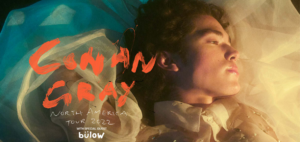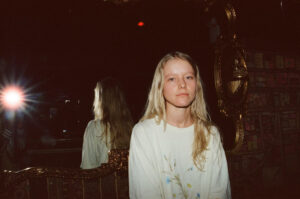On the night of the first snowfall in Washington, DC, dozens of colorfully underdressed audience members, most with large, ugly, green stamps on the back of their hands, waited in line outside The 9:30 Club for Louis the Child’s performance on Thursday, Nov.15. Chicago based DJ Dup Freddy Kennett and Robby Hauldren’s electronic music has earned them a nod from Taylor Swift and has been included in both FIFA 16 and an Apple advertisement. However, Louis the Child’s electronic whiffing at the DC concert just wasn’t strong enough to hold up without the vocalists the songs usually feature. The music ended up sounding repetitive and did not progress like other electronic hits such as Skrillex’s “First Of The Year” or Martin Garrix’s “Animals.” These songs build up; they tell a story. In the end, you feel like you’re not where you were at the beginning. This was not the case at this performance. At their Thursday show at The 9:30 Club, Louis the Child delivered stagnant beats during a concert that was only saved by the stage design and the opening musicians.
The first opening act was R.LUM.R. (pronounced are-luhm-are), an alternative-styled band. The keyboard player could be described as “how all keyboard players look,” which is to say kind of nerdy. The drummer looked like James Franco but with long, unwashed hair. Reginald Lamar Williams Jr., the singer R.LUM.R himself, had fire falsetto and flipped his rockstar hair in wildly algorithmic arcs. It would be glamorous to see him headlining even if it meant giving up seeing him in intimate venues like The 9:30. Kennett and Hauldren of Louis the Child, on the other hand, didn’t even have enough of a presence on stage (partly because they were bent over their boards and obscured by a large crown statue on stage) to be remarkable in appearance or personality.
The second opener was NoMBe, the alias of Noah McBeth. Refreshingly, McBeth’s band consisted of all girls, two on guitar and one on drums. McBride also played guitar, albeit a fancy see-through one that colorfully lit up. He wore what looked like a homemade muscle tee, and danced like he was alone in his room listening to the songs of his childhood. At first, NoMBe was not especially gripping, with vague pop-ish songs. Towards the end of his setlist, however, NoMBe played a couple songs (e.g. “California Girls,” “Milk & Coffee”) in a more rock, even grunge-esque style. These songs struck a chord and were more powerful because they came from a sincere place. Maybe the earlier songs were written to be hits, and he started with them because they are closer to Louis the Child’s music style, but these last songs were truly his songs, and he performed them so.
After McBeth came the main act. Louis the Child’s stage set consisted of simple wall projections on the back wall and a large neon sign in the shape of a crown—a typical Louis symbol—standing center stage. The crown was oddly placed in front of Kennett and Hauldren, so that they were half-obscured during the entire show. This would’ve been concerning if the DJs were performers, but since they mostly stayed at their DJ table, looking down, the audience wasn’t missing much. They did occasionally jump onto the table and bounce, but they were mainly reserved in their act on stage.
Before the performance began, the back wall of the stage projected a slideshow of stylistically low-quality photos of the band and associates, giving the audience a glimpse into their life offstage. These were not just ordinary photos; the people in each image were glitching, alive in a robotic way. On each side of the changing images, two messages were alternatively displayed: TEXT US and a phone number.
Upon texting the number on the screen, even just a “Hey Louis,” an audience member would receive a Soundcloud link promoting a remix the two DJs had recently created. Once the concert started, the back wall photo projections ended and began showing gorgeous and mesmerizing psychedelic graphics. The colorful designs, matching the electronic music and moving to the beat, transported the audience from the dark grunge atmosphere of The 9:30 Club into a communal shroom experience.
A couple of minutes past eleven and some keys into their song “It’s Strange,” Kennett and Hauldren stopped the music and the lights went on. One of them started talking into the microphone, asking two people in the audience to stop fighting. He said that we were all friends here. The crowd cheered. Into the crowded intensity of the pit, he called for the two to shake hands. It was impossible to see what was happening or even where. Only the artists’ unique vantage point on stage allowed them to spot the two brawlers. Louis the Child did not kill it in concert, but they at least promoted peace over violence.
The music was not the kind one would stand listening to, absorbed. This music was meant to be danced to, yet the crowd prevented any possibility of movement. Some of their more successful songs, like “It’s Strange,” succeeded in developing over time and thus better focused the crowd (once the fight was over). At other times, however, without lyrics or a strong stage presence, the mind wandered into a place where the music was only a sweet backdrop to one’s own thoughts. Everyone was in their own world. Louis the Child did not give a bad concert at all, but it was not a concert in the traditional sense. Not many people came there to listen to the music live, if electronic music can even be called live. This type of concert was more akin to an overcrowded dance club, where you might try to pay attention, in vain, to the DJ’s machinations.
If you go to a concert for the music, Louis the Child is not the best choice. Their live performances are prolonged beats, lacking the progression and vocals many of their studio-recorded songs have, such as “Better Not” ft. Wafia. Moreover, the concert was not about their performance. The audience rarely seemed to be present for Louis the Child’s sake, but rather to enjoy a club for all ages with live performers. The opening acts had much smaller crowds, and yet, or maybe because of them, the audience who was there paid attention to the music and connected with the musicians on stage. The musicians seemed to be in a much more intimate setting with them than Kennett and Hauldren, whose shoulders only pointed out towards the audience, sometimes even those hidden by the very large, neon crown sitting majestically central.





